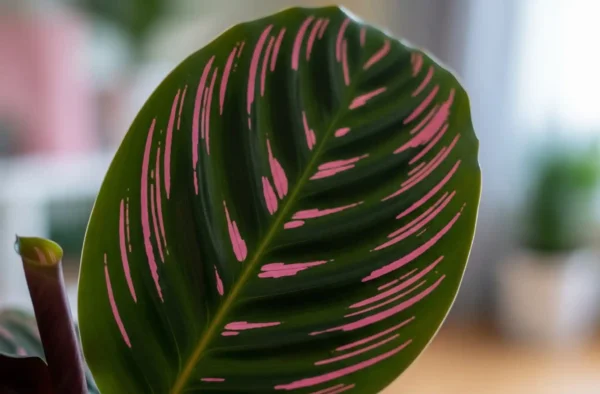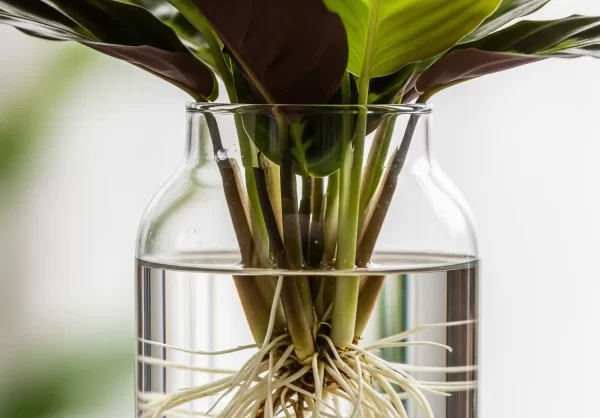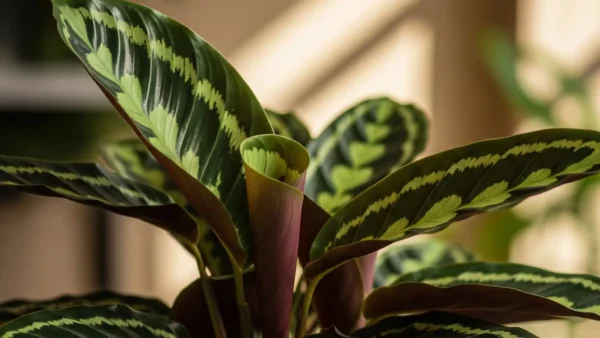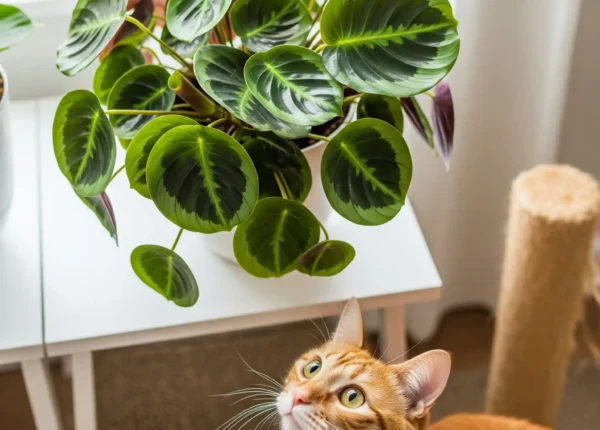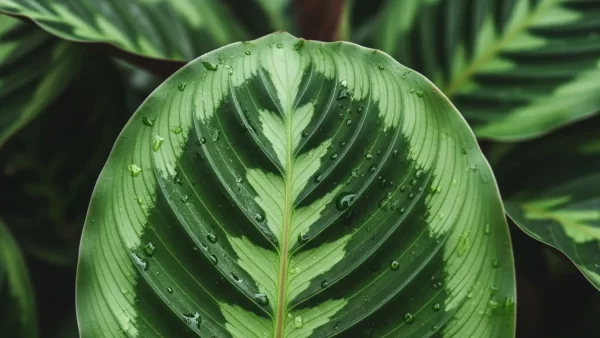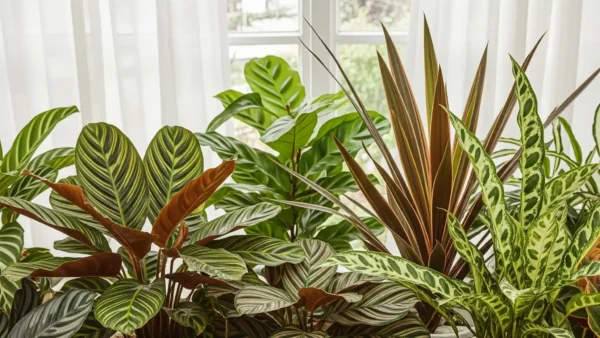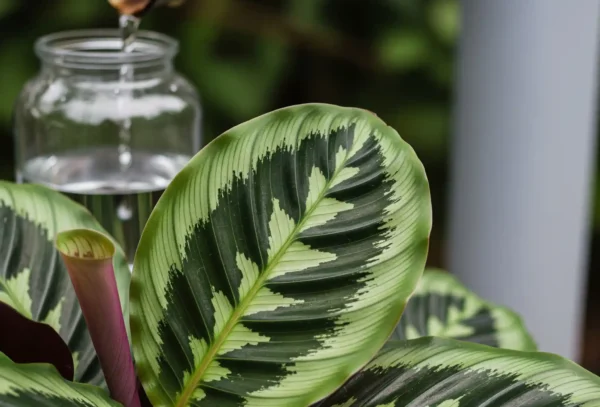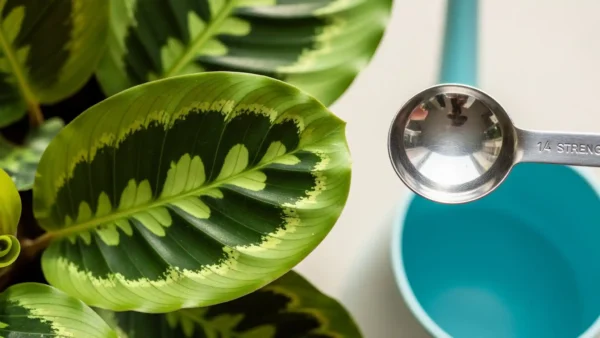The Key to Getting More Calatheas: Why Division is the Only Way
You probably want more of your Calathea’s beautiful leaves in your life if you adore it. But before we get our tools, we need to know one important thing about these beautiful plants: the only way to successfully grow a Calathea is to divide it.
Calatheas are a type of plant called a rhizomatous plant. This means that they grow and spread from a thick, underground stem called a rhizome. The rhizome is the plant’s main source of energy, and it sends up new shoots and roots. You need to give a new plant a bit of this important rhizome, along with its own leaves and roots, in order for it to grow. No matter how pretty a single leaf or bit of stem is, it doesn’t have the right biological parts to make a whole new plant.
Calatheas don’t grow via leaf cuttings or water propagation.
You may simply grow new plants from a cutting of a common houseplant, like a pothos or a philodendron, by putting it in water. The reason for this is that their stems have structures called nodes that keep latent cells that can make new roots. Calatheas, on the other hand, don’t have these nodes on their leaf stalks. The rhizome is the “brain” and “engine” of the whole Calathea. A leaf is merely a leaf without a piece of that rhizome; it can’t and won’t grow roots.
From what I’ve seen: A lot of rookie plant parents, and even some who have been at it for a while, have tried putting a pretty Calathea leaf in a vase of water and hoping for the best. It’s a fun experiment! It might stay green for a week or two, but it will never grow roots. Believe me, I’ve been through the heartbreak and answered the questions. To spare you time and emotional energy, let’s stick to the tried-and-true technique of division.
How to Get Your Calathea Ready for Propagation: Setting Up for Success
Before you even take the plant out of its pot, you need to do something to make sure the propagation goes well. In the days before the division, doing a few basic things will greatly lower stress on both the parent plant and the new divisions, which will help everyone recover quickly.
This is like a list of things to do before your plant surgery. Before the surgery, you want to make sure your Calathea is as healthy, hydrated, and strong as possible.
The Checklist Before Propagation:
- Choose the Right Time: The optimal time to propagate is while plants are actively growing, which is usually from spring to early summer. Because your plant has been getting good light for months, it has a lot of stored energy right now. This makes it ready to recover and develop new leaves quickly. Don’t propagate in the fall or winter when the plant is naturally slowing down.
- Check the health of the plant: Only propagate a plant that is healthy and growing well. If your Calathea has pests, sickness, or leaves that are turning brown quickly, you should first focus on getting it back to health. If you divide a weak plant, it will fail.
- Water your Calathea well one to two days before you plan to divide it. A plant that is well-watered is stronger. The stems and roots will be firm and flexible, which will make them less prone to break during the procedure. This one step makes transplant shock a lot less likely.
When you’re already intending to repot your Calathea, that’s the best time to propagate it. It’s the best time to divide it because you’ll be taking it out of its pot anyhow and won’t have to worry about it.
Before I plan to propagate, I always inspect my Calathea for bugs a week ahead of time. Wipe down the leaves well and look in the cracks. You don’t want to find out about a pest problem when you’re working on your plants, or worse, accidentally spread a growing infestation to all of your fresh, weak divisions.
A Step-by-Step Guide to Dividing Your Calathea
This is the time. Breathe deeply. Keep in mind that you are not hurting your plant; you are helping it grow. This method is easy and quite gratifying if you have a light touch and some confidence.
Your Tools:
- A clean tarp or some old newspapers to use
- A sharp knife or pruners that have been sterilized
- New pots that drain well and are the right size for your divisions
- New potting mix that drains properly
Pro Tip: Why Sterilization Is Important
It’s very important to clean your instruments before you start cutting. Plant tissue can get infected exactly like human tissue. If you use a dirty knife, it can put germs or fungi right into your plant’s vascular system. You may easily clean your instruments by washing down the blades with rubbing alcohol or putting them in a solution of 1 part bleach to 9 parts water.

The Process of Division:
- Gently Unpot: Lay the plant on its side and gently squeeze the pot to remove the root ball. Carefully pull the whole plant out. Don’t pluck it by the stems, as this could hurt it.
- Expose the Root System: After taking the plant out, start gently massaging the root ball to break up the old soil. Gently shake it and use your fingers to pull the dirt away from the roots. You want to be able to see the root and rhizome structure clearly.
- Know the Anatomy: Take a second to figure out what you’re looking at. You will see a tangle of thin, fibrous roots. Their duty is to soak up water. You should be able to see the rhizomes woven amongst them. These structures are thicker, fleshier, and more like ginger, and they feel substantial and firm. They are the energy packets and the things that make things grow.
- Find Your Divisions: Look for natural groups or parts of the plant. A grown-up Calathea will usually have a few groups of stems that are easy to tell apart. These are the best people for you to divide.
What Makes a Division Work? The Golden Rule
This is the most crucial thing to remember when growing Calathea. Every new plant you make needs a full system to stay alive.
A viable division contains at least two or three healthy leaves, a solid piece of rhizome, and its own healthy, established part of the root system attached.
If a part has leaves but very few roots, or if it has roots and rhizomes but no leaves, it will very probably fail.
Before you cut, attempt to gently pull the root ball apart with your fingertips. A lot of the time, the plant will have natural places where you can peel it apart without any effort. If the thick, woody rhizome connections won’t come apart by hand, use your sterilized knife to make a clean, sharp cut.
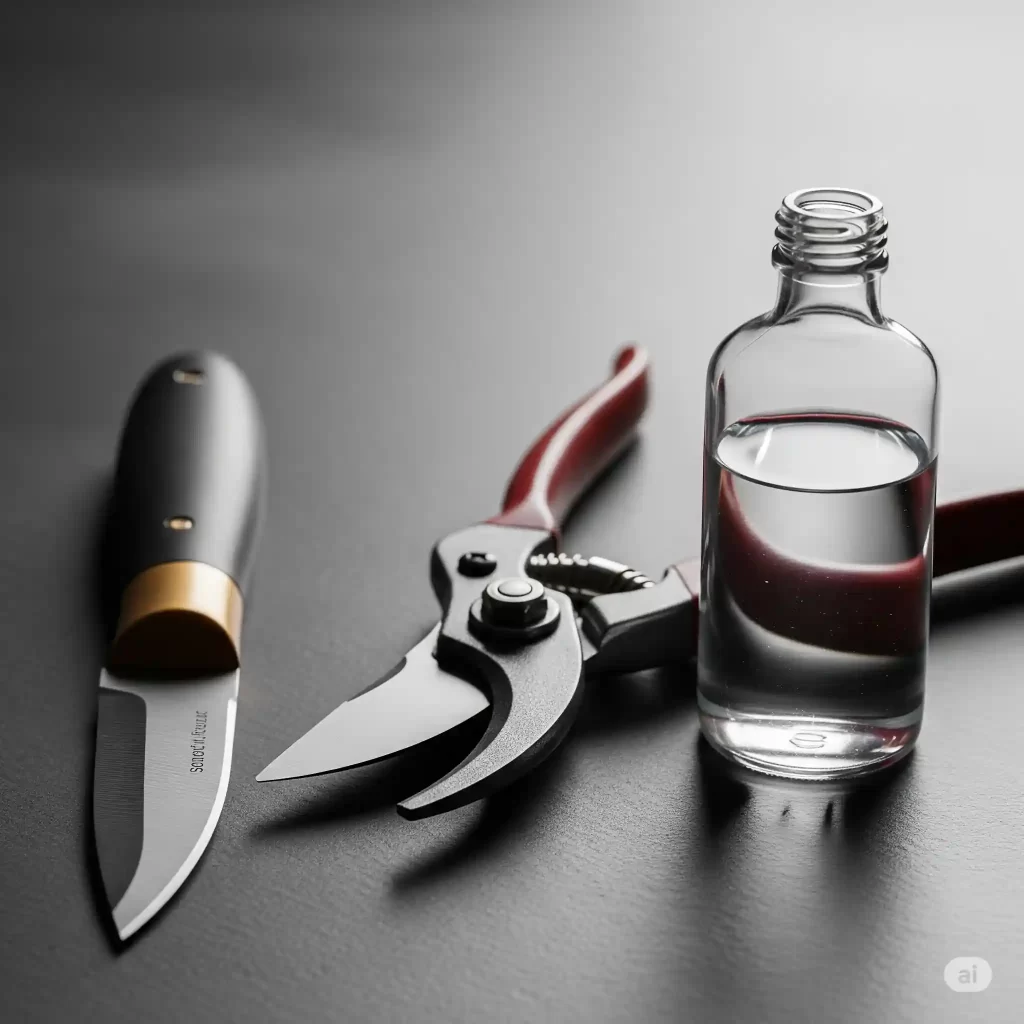
Put Your New Plants in Pots: Put each new division in its own pot with fresh soil. Pick a pot that is just the right size for the new root ball, with about one inch of space around it. If the pot is too big, it will hold too much water, which might cause root rot. Carefully fill in the hole with dirt, making sure the plant is at the same depth as it was in the original container.
Expert Tip: Always make two or three big, healthy divisions instead of five or six little, weak ones that will have a hard time living. If you’re not sure, it’s better to make fewer, stronger divides.
Post-Propagation ICU: A New Divisions Care Plan for 4 Weeks
Your new Calathea divisions just had a big surgery. They need to go to a “Intensive Care Unit” to get better now. For the following month, your responsibility is to make sure they have a low-stress, high-humidity environment where they can focus all their efforts on mending and establishing new roots.
Taking care of the new divisions
The new division has a smaller, less efficient root system, which makes it hard for it to get enough water to keep the leaves alive. This is why the most important thing for success is to keep the humidity very high. It cuts down on the quantity of water that the leaves lose to the air (transpiration), which gives the new roots time to grow.
The ICU Plan:
- Make a Humidity Dome: The best approach to keep the humidity high all the time is to make your own greenhouse. Put a clear plastic bag over the pot and use chopsticks or skewers to hold it high so it doesn’t contact the leaves.
- Give the air a chance to flow: You need to take the bag off for roughly an hour every day. This lets fresh air flow through and stops mold and fungus from growing in the air that isn’t moving and is too humid.
- Light and Water: Put the new divisions in a place with mild, indirect light. The soil should always be wet, like a sponge that has been wrung out, but never soggy.
- No fertilizer: The new roots are soft and might be burned easily. For at least 6–8 weeks, or until you see at least two new leaves open up, do not fertilize.
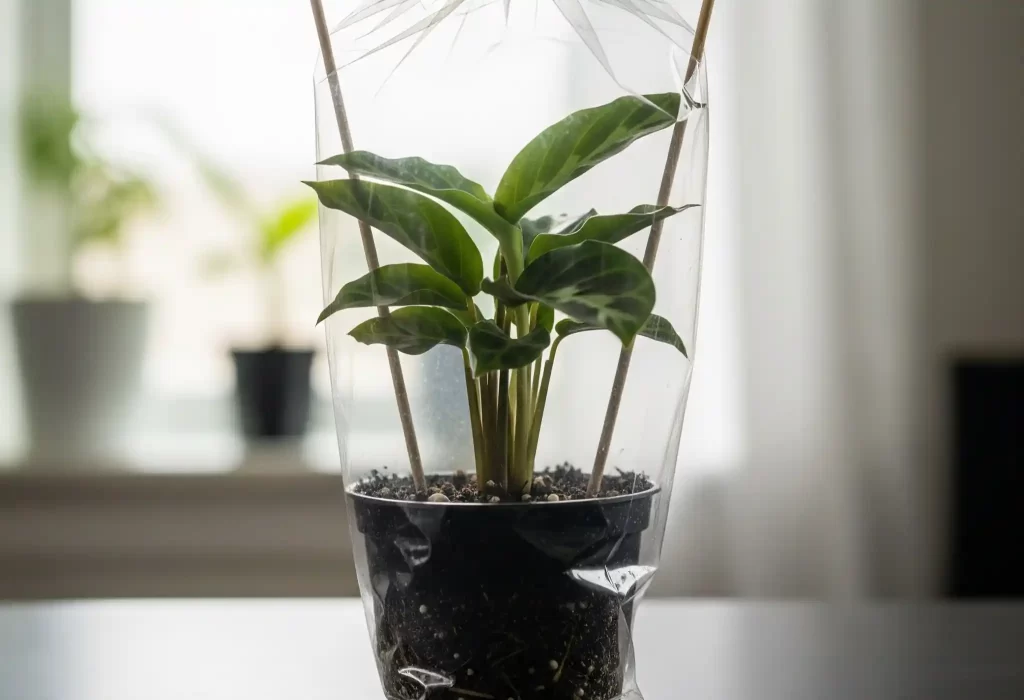
Timeline for Success:
| Week | What to Look Forward To | Your Work |
|---|---|---|
| Week One | A lot of wilting and drooping. The plant will seem unhappy. This is normal shock. | Keep the soil moist and the air humid. Be patient. |
| Second week | The wilting should get better. The plant could still look droopy, but it should look more stable. | Keep giving care in the ICU. Don’t water too much. |
| 3–4 weeks | The plant should be mainly standing up straight and look a lot better. When a fresh, tightly curled leaf starts to grow from the ground, you should know that you have reached your goal. | Have a party! You can probably take off the humidity dome now, but maintain the plant in a place that is still damp. |
Taking care of the Mother Plant once it has been divided
Don’t forget about the first plant! It has also been under a lot of stress. Put it back where it likes to be and keep caring for it as usual, but make sure to pay close attention to how much water it requires. It may not need water as often since that its root ball is smaller. It should come back in a few weeks.
Based on what I’ve seen, the most common mistake is for folks to give up on a division after a week because it looks terminally wilted. It’s true that transplant shock happens, and it happens a lot with Calatheas. Stick to the ICU plan and be patient as long as the stems don’t turn to mush. It will surprise you with how strong it is and how quickly it bounces back.
What to Do When Propagation Goes Wrong: Troubleshooting
You could still have questions or worries, even if you are well-prepared. This is a calm guide to the most typical worries that come up after propagation.
“Help! My fresh division is all wilted and looks lifeless!”
Most of the time, this is just typical transplant shock. Don’t freak out! Go through this list: Is the humidity dome on and keeping moisture in? Is the ground wet but not too dry or too wet? Is the plant not getting any direct sunlight? If the answer to these questions is yes, all you have to do is wait.
“The mother plant looks awful now that I’ve cut it up!”
This is also a normal shock. It will heal as long as you leave a good, healthy part of the original plant. Make sure it’s back in its happy area, and be careful not to water it too much now that its roots are smaller. It should feel better in a few weeks.
“A leaf on my new division turned yellow and died. Did I fail?”
No way! This could actually be a good indicator. The plant is being smart and “sacrificing” an older leaf that isn’t working as well to focus that energy on growing new roots that are really important. This is a typical component of the recovery process as long as the other leaves seem healthy.
“Can I put two small divisions in one pot to make it look bigger?”
It’s best not to. This is enticing, but it makes the two weak plants struggle for the same limited resources (water and nutrients) while they are attempting to get better. Let each division grow without having to compete with the others.
“Since I split my mother plant, it hasn’t grown at all. What did I do wrong?”
You probably didn’t do anything wrong. The plant is probably putting all of its energy into repairing and growing its roots back below the ground, where you can’t see it. It will start growing new leaves again once the roots are healthy again. You need to be patient.
Have fun with your growing collection of calathea.
Well done! You have successfully completed one of the most satisfying (and scary) parts of taking care of houseplants. You have not only added to your collection, but you have also learned more about these amazing plants by taking the time to learn about their needs, getting ready, and taking care of them thereafter.
Important things to remember about fear-free propagation:
- The process itself is just as vital as making sure the mother plant is healthy and well-prepared.
- A viable division is a full mini-plant with roots and leaves connected by a rhizome.
- The only way to help new divisions get over shock is to keep the humidity high.
- Don’t freak out when you see the first indication of wilting; patience is your best friend.
Questions and Answers (FAQ)
How big does my Calathea need to be before I can split it?
Your plant should be full, healthy, and mature, and it should probably be in a pot that is at least 6 inches wide. The most important thing is that it should have clear, separate groups or clumps of growth that you can see as possible divisions.
Is this how I may grow all kinds of Calathea?
Yes! This way of dividing works for all the common types in the Calathea, Maranta (Prayer Plant), Ctenanthe, and Stromanthe genera since they all develop from a similar rhizomatous structure.
How long will it take for my fresh division to appear like a whole plant?
You need to have realistic expectations. It could take a whole growing season or even a year for a modest division with 2–3 leaves to grow into the full, lush plant you want. Enjoy the process of seeing it grow.
What kind of soil is ideal for Calatheas that have just been propagated?
To keep things the same, use the same fresh, well-draining mix for both the mother plant and the young divisions. A high-quality combination of 1 part potting soil, 1 part perlite, and 1 part orchid bark or coco coir gives the exact balance of moisture retention and aeration that Calatheas adore.
Can I put rooting hormone on the divisions?
Yes, you can, but it’s not usually necessary for Calathea division. The rhizome already has all the hormones it needs to grow new roots. A light dusting on the cut sections won’t hurt, but giving them the right care afterward, especially keeping the humidity high, is far more vital for success
Sources
Gang, Q., Dai, X., Wu, M., Wang, X., Chen, J., Liu, C., … & Wang, L. (2018). Biochemical and Physiological Characteristics of Photosynthesis in Plants of Two Calathea Species. International Journal of Molecular Sciences, 19(3), 704. https://www.mdpi.com/1422-0067/19/3/704
Kaewsuksaeng, S., Thepsithar, C., Soonthornkalump, S., & Meesawat, U. (2014). Micropropagation of an Exotic Ornamental Plant, Calathea crotalifera, for Production of High Quality Plantlets. The Scientific World Journal, 2014, 457092. https://doi.org/10.1155/2014/457092
Rahman, M. M., Ahmad, S. H., Mohamed, M. T. M., & Rahman, M. Z. A. (2015). Antimicrobial compounds from leaf extracts of Jatropha curcas, Psidium guajava, and Andrographis paniculata. The Scientific World Journal, 2014, 635240. https://doi.org/10.1155/2014/635240
Silva, T. P., Pinheiro, A. L., Pommer, C. V., & Santos, H. S. (2019). Propagation techniques for ornamental plants of the Marantaceae family. Ornamental Horticulture, 25(3), 290-298. https://doi.org/10.14295/oh.v25i3.2098
Wahyuningtyas, R. S., Solichatun, S., & Anggarwulan, E. (2017). Growth and development of Calathea zebrina under different light intensities in tissue culture. Biosaintifika, 9(2), 244-251. https://journal.unnes.ac.id/nju/index.php/biosaintifika/article/view/9671


